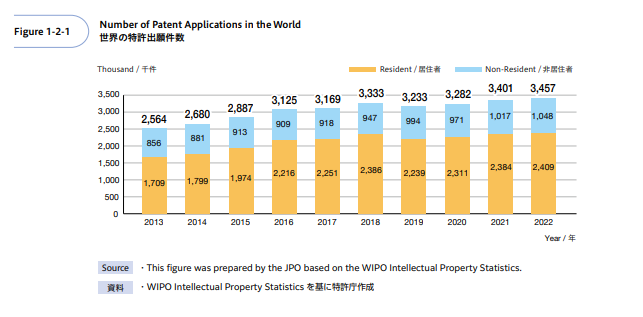APRIL 2024 - IP UPDATE
- April 22, 2024
- Newsletter
- APRIL 2024 NEWSLETTER
.png)
USPTO UPDATES
USPTO Advances Rules Governing PTAB Review Practices
BY SAMEER GOKHALE
On April 18, 2024, the USPTO announced a Notice of Proposed Rulemaking (NPRM) seeking public feedback on proposals to codify many existing PTAB (Patent Trial and Appeal Board) review policies and practices. The rules are proposed based on stakeholder feedback received in response to an October 2020 Request for Comments (RFC) and an April 2023 Advance Notice of Proposed Rulemaking (ANPRM). As described in the Summary for the announcement, “[t]he proposed rules would enhance and build on existing precedent and guidance regarding exercise of the Director’s discretion to determine whether to institute an AIA proceeding with regard to serial petitions, parallel petitions, and petitions implicating the same or substantially the same art or arguments previously presented to the USPTO. The proposed rules would also establish a separate briefing process for discretionary institution arguments and align the procedures for termination of proceedings pre- and post-institution.”
JPO UPDATES
BY KASUMI KANETAKA
The JPO Status Report 2024 was released in March 2024. The Report consists of statistical information, such as trends in Intellectual Property in Japan and Worldwide, and policy outcomes from 2023. According to the Report, the number of patent applications in Japan has increased since 2020, and it surpassed 300,000 cases in 2023. The number of patent applications in the World has been increasing since 2019.
Patent Examination Case Examples Pertinent to AI-related Technologies
The JPO created and published Case Examples on AI-related technologies with the aim of providing clear guidance on determining Inventive Step, Description Requirement and Eligibility of them. There were 15 examples published by January 2019, and the JPO added 10 more examples as of March 13, 2024. Please see here for the full text of the Case Examples.
“AI Advisor” Is Newly Established to Support Patent Examiners at the JPO
On March 28, 2024, the Ministry of Economy, Trade and Industry announced that the JPO, effective April 1, 2024, would newly establish an “AI Advisory” who will provide support based on expert knowledge of AI-related technologies to patent examiners, including AI officers.
In January 2021, the JPO established the AI examination support team which consists of the AI officers and management staff. As of October 1, 2023, the number of AI officers tripled, from 13 to 39. As a “hub” for examining AI related technologies, the AI officers gather information and insights from each examination department and consult with examiners outside the AI examination support team to support realizing the efficient and sophisticated examinations.

Data Learning Phase May Not Be Subjected to Intellectual Property Regulations on AI
On March 21, 2024, the Cabinet Office of Japan held an online meeting, “Intellectual Property Rights Study Group in the AI Era” and discussed generative AI and protections of the IP rights. According to the outline of an interim report, the study group confirmed that, in principle, there is no infringement of IP rights, except copyright, when AI is operated under a phase of data learning. This is the 6th meeting held since October 2023. Based on the outline, the interim report will be formed by April 2024 and will be reflected in the government’s IP promotion plan announced around June 2024.
Regarding copyright, in February 2024, the Agency of Cultural Affairs compiled an idea that the unauthorized use of texts, images, etc. by AI may constitute copyright infringement. Besides the Cabinet Office and the Agency of Cultural Affairs, the Ministry of Economy, Trade and Industry is also discussing the AI policy.
CAFC UPDATE
Federal Circuit Upholds PTAB Finding of Patentability in Medtronic v. Teleflex Life Sciences
BY JENNA LOGSDON
On March 21, 2024, in Medtronic, Inc. v. Teleflex Life Sciences Ltd. the Federal Circuit upheld the Patent Trial and Appeal Board (PTAB) decision that U.S. Patent No. 8,142,413 (“the ‘413 patent”), owned by Teleflex, was not shown to be unpatentable over the asserted prior art.
Medtronic filed two inter partes review (“IPR”) petitions asserting that claims 1, 2, 4, 5, and 7–14 of the ‘413 patent are unpatentable. The PTAB issued a decision in both cases that the references do not anticipate nor render obvious the claims of the ‘413 patent, to which Medtronic appealed the obviousness assertions.
In the decision of the IPRs, the PTAB construed claim 1 to require performing the claimed steps in the recited order. The PTAB relied on this determination to conclude that claim 1 of the ‘413 patent was not obvious over some of the cited references. Medtronic argued that the PTAB erred by construing sequential performance of the recited steps, specifically, stating that certain steps could be performed simultaneously.
The Federal Circuit agreed with the PTAB claim interpretation, asserting that although the steps of the method claim do not actually recite an order, the ordering of steps is interpreted in view of the claim language and the specification.
For a more detailed analysis, please see the Life Sciences Blog Post on the decision here.
AI UPDATE
USPTO Issues Detailed Guidance on Use of AI-Based Tools Before the Office
BY SAMEER GOKHALE
On April 11, 2024, the USPTO issued “Guidance on Use of Artificial Intelligence-Based Tools in Practice Before the United States Patent and Trademark Office.” The Guidance is intended to inform practitioners and the public of the important issues that patent and trademark professionals, innovators, and entrepreneurs must navigate while using Artificial Intelligence (AI) in matters before the USPTO. This publication follows an initial memorandum submitted on February 6, 2024 which briefly discussed this topic. In particular, the new Guidance provides requirements for all submissions and correspondence with the USPTO, stating that any paper submitted to the USPTO must be reviewed by the party or parties presenting the paper and that simply relying on the accuracy of an AI tool is not a reasonable inquiry. In the patent context, the Guidance states that “if the use of an AI tool is material to patentability as defined in 37 CFR 1.56(b), the use of such AI tool must be disclosed to the USPTO.” One such example occurs “when AI makes contributions to drafting portions of the specification and/or claims (e.g., introducing alternate embodiments not contemplated by the inventor(s)), it is appropriate to assess whether the contributions made by natural persons rise to the level of inventorship, in accordance with the law and recent USPTO guidance.” The Guidance from the USPTO should be carefully considered, especially as AI software tools to assist in the preparation and prosecution of patents become more prevalent among patent practitioners.
LIFE SCIENCES UPDATES
Medical Image Display Determined to be an "Abstract Idea"
BY RICHARD D. KELLY
TheFederalCircuitin AI Visualize, Inc. v. Nuance Communi-cations, Inc., Appeal 2022-2109, on April 4, 2024, affirmed the district court decision that the asserted claims in AI’s patents U.S. Patent Nos. 8,701,167 (‘167 patent), 9,106,609 (‘609 patent), 9,438,667 (‘667 patent), and 10,930,397 (‘397 patent) all were invalid for claiming an abstract idea, 35 U.S.C. § 101. The patents all shared a common disclosure and are directed to system claims for displaying a 3-dimensional medical image stored on a central device at a remote location where they could be accessed and displayed at a remote display connected to the central sever by a low-speed connection such as the internet. All the claims were directed to a system to achieve the objective. The problem was that the system was conventional, and the invention was not found in the claims, assuming there was one.
The claim language does not claim how the objective was to be achieved but rather the function.
The following is an example from claim 1 of ‘609:
a web application adapted to satisfy a user’s request for the three-dimensional virtual views by: a) accepting at a remote location at least one user request for a series of virtual views of the volume visualization dataset, the series of views comprising a plurality of separate view frames, the remote location having a local data storage medium for storing frames of views of the volume visualization dataset,
The same is true for all the claim limitations. In the opening brief the invention was described:
The Asserted Patents provide solutions to the problem of processing and transmitting large volumes of data over the Internet that overcome the low bandwidth and high latency limitations inherent in the standard Internet. See Appx112 (Dkt. 22 at ¶56); Appx58 (’609 Pat. at 1:25 – 2:3, 2:35-42). Another benefit of the claimed inventions is a reduction of costs associated with conventional systems. See e.g., Appx102 (Dkt. 22 at ¶34); Appx58 (’609 Pat. at 1:56-58). (Op. Br. At 10)
The Asserted Patents provide solutions to the problem of processing and transmitting large volumes of data over the Internet that overcome the low bandwidth and high latency limitations inherent in the standard Internet. See Appx112 (Dkt. 22 at ¶56); Appx58 (’609 Pat. at 1:25 – 2:3, 2:35-42). Another benefit of the claimed inventions is a reduction of costs associated with conventional systems. See e.g., Appx102 (Dkt. 22 at ¶34); Appx58 (’609 Pat. at 1:56-58). (Op, Brief at 11)
At no point how these and other solutions to the alleged problems are to be implemented is found in the claims. Functionality only is provided. The claims by using functional limitations only are preempting all solutions to the problem.
Attorneys and applicants should remember the old axiom that that claims are to be directed to what the invention is and not to what is does.










 Counseling & Strategic Advice
Counseling & Strategic Advice IP Transactions
IP Transactions Litigation
Litigation PTAB Proceedings
PTAB Proceedings Technology Transfer
Technology Transfer Trademark & Designs
Trademark & Designs U.S. Patent Procurement (Application Drafting & Prosecution)
U.S. Patent Procurement (Application Drafting & Prosecution)







